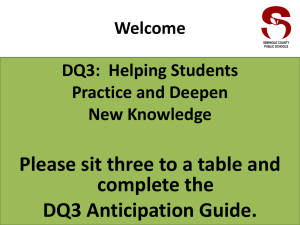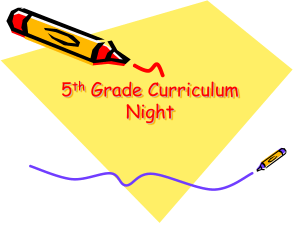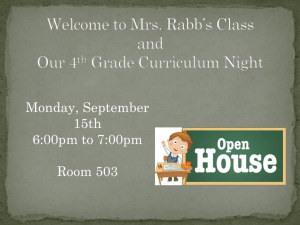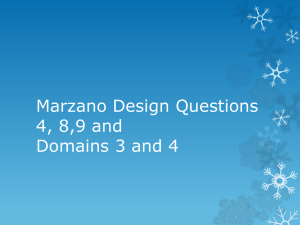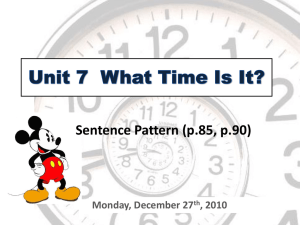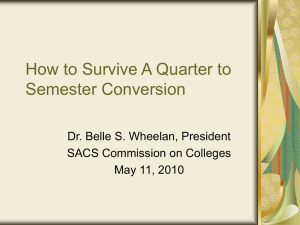Marzano Design Questions 2,3, and 5
advertisement
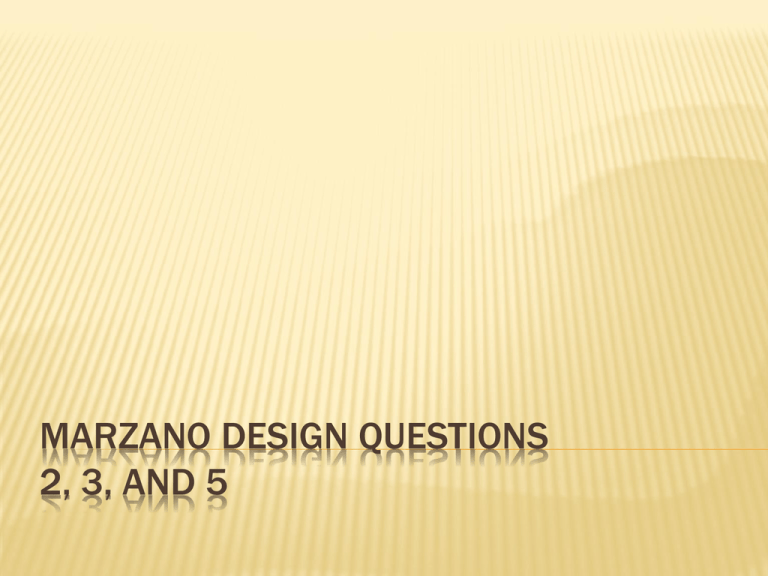
MARZANO DESIGN QUESTIONS 2, 3, AND 5 2ND QUARTER OBSERVATIONS Quarter 1st Quarter 2nd Quarter 3rd Quarter and 4th Quarter See TLE Guidelines page 6 Design Question/Domain Design Questions 1,6,7 and Domain 2 Design Questions 2,3, and 5 Design Questions 4,8, and 9 Deeper Connections with all Design Questions and Complete Domains 2-4 2ND QUARTER OBSERVATIONS- TEACHER FRAMEWORK 2ND QUARTER OBSERVATIONS- NONCLASSROOM FRAMEWORK 2ND QUARTER OBSERVATIONS The 2nd quarter observation will be a formal observation. Formal observations include the following: Minimum 30 minutes in length Pre-Conference Post-Conference Results used in final evaluation scores Written, actionable, and timely feedback provided to the teacher See TLE Guidelines Page 12 2ND QUARTER OBSERVATIONS Steps to a Formal Observation 1) Pre-Conference a. b. 2) 3) The teacher completes the short version of the PreConference form A in iObservation Meet with observer to discuss the lesson Formal Observation Post-Conference a. b. The teacher completes the short version of the PostConference form A in iObservation Meet with observer to reflect on the observed lesson See TLE Guidelines page 13 LEARNING GOALS Educators will understand the meaning of Design Questions 2,3, and 5. Educators will recognize various elements found in Design Questions 2,3, and 5. DESIGN QUESTION 2 HELPING STUDENTS INTERACT WITH NEW KNOWLEDGE DESIGN QUESTION 2 HELPING STUDENTS INTERACT WITH NEW KNOWLEDGE The first exposure to new knowledge sets the tone for how well a student will understand the knowledge. Teachers should ask the following questions: What is important? What medium will I use? How will I preview? How will I help my students reflect? DESIGN QUESTION 2 HELPING STUDENTS INTERACT WITH NEW KNOWLEDGE Desired Effect Remember! The Desired Effect is the intended result of the teacher’s strategy. What you want to happen as a result of that element. DESIGN QUESTION 2 HELPING STUDENTS INTERACT WITH NEW KNOWLEDGE ELEMENT (6) Identifying Critical Information DESIRED EFFECT (6) The teacher identifies critical verses non-critical information for students to know what’s important verses nonimportant. (9) Chunking Content into (9) When information is broken down “Digestible Bites” into small chunks, students can process the information effectively. (12) Recording and Representing Knowledge (12) Students will be able to demonstrate understanding of new content in a verbal or non-verbal format using a variety of media. DESIGN QUESTION 2 HELPING STUDENTS INTERACT WITH NEW KNOWLEDGE Activities for helping students record and interact with new knowledge (12) Combination Notes- In a table format, students will make written notes in the left column and pictorial representatives in the right column. DESIGN QUESTION 2 HELPING STUDENTS INTERACT WITH NEW KNOWLEDGE Activities for helping students record and interact with new knowledge (12) Academic Notebooks- Students will record initial understandings of a topic, and then make corrections and update their thinking as they review previous entries. DESIGN QUESTION 2 HELPING STUDENTS INTERACT WITH NEW KNOWLEDGE Activities for helping students record and interact with new knowledge (12) Dramatic Enactments- students can use roleplay to act out scenes, processes, or events. Students can also use their bodies to create symbols for concepts such as radius, diameter, and circumference. DESIGN QUESTION 2 HELPING STUDENTS INTERACT WITH NEW KNOWLEDGE It’s Video Time! www.effectiveeducators.com DESIGN QUESTION 2 HELPING STUDENTS INTERACT WITH NEW KNOWLEDGE After watching the video, discuss how your teaching is similar to the teacher in the video(s). Design Question 3 Helping Students Practice and Deepen New Knowledge DESIGN QUESTION 3 HELPING STUDENTS PRACTICE AND DEEPEN NEW KNOWLEDGE Lessons designed to practice and deepen knowledge begin with a review of the previously introduced content. Research shows that students need a minimum of three to four exposures with no more than a two-day gap between exposures before knowledge becomes integrated. DESIGN QUESTION 3 HELPING STUDENTS PRACTICE AND DEEPEN NEW KNOWLEDGE ELEMENT DESIRED EFFECT (17) Examining Similarities and Differences Students have a deeper understanding of similarities and differences of informational content and can explain what they know. (18) Examining Errors in Reasoning Students will be able to deepen their knowledge by examining errors using reasoning skills to support their viewpoint. (20 ) Revising Knowledge Teachers will engage students to examine, explain, and revise previously learned content. DESIGN QUESTION 3 HELPING STUDENTS PRACTICE AND DEEPEN NEW KNOWLEDGE Activities for Examining Similarities and Differences (17) Venn diagrams- compare and contract two or three people, places, events, concepts, or processes Sentence Stem comparisons________ is like _______ because ________________. __________ is not like __________ because ____________. DESIGN QUESTION 3 HELPING STUDENTS PRACTICE AND DEEPEN NEW KNOWLEDGE Activity for Examining Errors in Reasoning (18) Finding errors in the media- watch footage of political debates, commercials or interviews and ask students to find and analyze errors in reasoning in the message. DESIGN QUESTION 3 HELPING STUDENTS PRACTICE AND DEEPEN NEW KNOWLEDGE Activities for Revising Knowledge (20) Peer Feedback- students trade academic notebooks and respond in writing to each other’s entries. Assignment Revision- after completion of an assignment, the teacher provides comments and suggestions. The student uses this information to revise their assignment and resubmit. DESIGN QUESTION 3 HELPING STUDENTS PRACTICE AND DEEPEN NEW KNOWLEDGE It’s Video Time! www.effectiveeducators.com DESIGN QUESTION 3 HELPING STUDENTS PRACTICE AND DEEPEN NEW KNOWLEDGE After watching the video, discuss one activity or process that you will take back to your classroom. Design Question 5 Engaging Students DESIGN QUESTION 5 ENGAGING STUDENTS To stimulate and maintain student engagement, a teacher must constantly evaluate the extent of the student’s attention. If students are engaged, the teacher continues with the lesson. If students are not engaged, the teacher uses one of the other elements in Design Question 5 to re-engage students. DESIGN QUESTION 5 ENGAGING STUDENTS ELEMENTS DESIRED EFFECT (25) Using Academic Games Students are continuously engaged or re-engaged with inconsequential competition through the use of games. (27) Using Physical Movement Teacher uses physical movement to engage and reengage students in the learning process. (29) Demonstrating Intensity and Enthusiasm Students will state that the teacher makes learning fun by engaging and re-engaging with intensity and enthusiasm. DESIGN QUESTION 5 ENGAGING STUDENTS Activities for Using Academic Games (25) Name That Category- Similar to “The $100,000 Pyramid.” Each team will have a “clue giver” and one or more guessers. The teacher reveals the category and the “clue giver” must list words that fit in the category until teammates identify the category. What is the Question?- Similar to Jeopardy. DESIGN QUESTION 5 ENGAGING STUDENTS Activity for Using Physical Movement (27) Give One Get One- Using Academic Notebooks, students are placed in pairs. Students will compare each notebook. Then each student will share at least one piece of information they recorded that the other did not. DESIGN QUESTION 5 ENGAGING STUDENTS Activity for Using Physical Movement (27) Vote With Your Feet- the teacher posts a sign in each corner of the room with answers to questions. The teacher asks the question and the students go to the corner that has what they think is the right answer. Before the answer is revealed, the teacher asks students in each group why they think their answer is correct. DESIGN QUESTION 5 ENGAGING STUDENTS Activity for Demonstrating Intensity and Enthusiasm (29) Personal Stories- The teacher (or student) shares a personal story about the content. Example: On my trip to Brazil, I was able to visit “O Cristo Retendor” (“Christ the Redeemer.”). Provide artifacts from the trip. DESIGN QUESTION 5 It’s Video Time! www.effectiveeducators.com DESIGN QUESTION 5 After watching the video, what do you do to engage students? How does it align with the elements of Design Question 5? QUESTIONS? Alicia Currin-Moore Director, Performance Management and Accountability Aqcurrin-moore@okcps.org 405.587.0817 (work) 405.306.7129 (cell)
